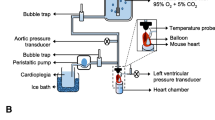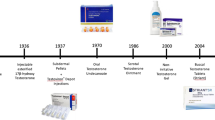Abstract
Further to our previous observation of post-mortem cardiac lesions after sudden death in several athletes with a history of anabolic steroid abuse, this study was intended to reproduce these lesions in rabbits administered testosterone oenanthate, a prototypic anabolic steroid abused by athletes, and to provide evidence for the protective effects of trimetazidine and dexrazoxane that are used as antianginal and cardioprotective drugs, respectively. Groups of six rabbits each were administered saline, testosterone, or a combination of testosterone and either trimetazidine or dexrazoxane for 3 months. Histologic cardiac lesions including necrosis, misshapen cell nuclei, interstitial and endocardial fibrosis, lymphocytic infiltrates, and vascular dystrophies were observed in testosterone-treated rabbits. In contrast, no significant lesions were observed in the animals treated with testosterone combined with either trimetazidine or dexrazoxane. This is the first study providing evidence for testosterone cardiotoxicity following sub-chronic exposure in laboratory animals. In addition, these results suggest the protective role of trimetazidine and dexrazoxane.

Similar content being viewed by others
References
Deligiannis, A., Björnstad, H., Carre, F., Heidbüchel, H., Kouidi, E., Panhuyzen-Goedkoop, N. M., et al. (2006). ESC study group of sports cardiology position paper on adverse cardiovascular effects of doping in athletes. European Journal of Cardiovascular Prevention and Rehabilitation, 13, 687–694. doi:10.1097/01.hjr.0000224482.95597.7a.
Kindermann, W. (2006). Cardiovascular side effects of anabolic-androgenic steroids. Herz, 31, 566–573. doi:10.1007/s00059-006-2856-0.
Di Paolo, M., Agozzino, M., Toni, C., Luciani, A. B., Molendini, L., Scaglione, M., et al. (2007). Sudden anabolic steroid abuse-related death in athletes. International Journal of Cardiology, 114, 114–117. doi:10.1016/j.ijcard.2005.11.033.
Fineschi, V., Riezzo, I., Centini, F., Silingardi, E., Licata, M., Beduschi, G., et al. (2007). Sudden cardiac death during anabolic steroid abuse: Morphologic and toxicologic findings in two fatal cases of bodybuilders. International Journal of Legal Medicine, 121, 48–53. doi:10.1007/s00414-005-0055-9.
Pärssinen, M., Kujala, U., Vartiainen, E., Sarna, S., & Seppälä, T. (2000). Increased premature mortality of competitive power lifters suspected to have used anabolic agents. International Journal of Sports Medicine, 21, 225–227. doi:10.1055/s-2000-304.
Luke, J. L., Farb, A., Virmani, R., & Sample, R. H. (1990). Sudden cardiac death during exercise in a weight lifter using anabolic androgenic steroids: Pathological and toxicological findings. Journal of Forensic Sciences, 35, 1441–1447.
Maron, B. J., Epstein, S. E., & Roberts, W. C. (1986). Causes of sudden death in competitive athletes. Journal of the American College of Cardiology, 1, 204–214.
Corrado, D., Basso, C., Pavei, A., Michieli, P., Schiavon, M., & Thiene, G. (2006). Trends in sudden cardiovascular death in young competitive athletes after implementation of a preparticipation screening program. Journal of the American Medical Association, 296, 1593–1601. doi:10.1001/jama.296.13.1593.
Fanton, L., Belhani, D., Vaillant, F., Tabib, A., Gomez, L., Descotes, J., et al. (2008). Heart lesions associated with anabolic steroid abuse: Comparison of post-mortem findings in athletes and norethandrolone-induced lesions in rabbits. Experimental and Toxicologic Pathology, (Nov), 20. Epub ahead of print.
Bertomeu-Gonzalez, V., Bouzas-Mosquera, A., & Kaski, J. C. (2006). Role of trimetazidine in management of ischemic cardiomyopathy. The American Journal of Cardiology, 98(5A), 19J–24J. doi:10.1016/j.amjcard.2006.07.005.
Wiseman, L. R., & Spencer, C. M. (1998). Dexrazoxane. A review of its use as a cardioprotective agent in patients receiving anthracycline-based chemotherapy. Drugs, 56, 385–403. doi:10.2165/00003495-199856030-00009.
Hartgens, F., & Kuipers, H. (2004). Effects of androgenic-anabolic steroids in athletes. Sports Medicine (Auckland, N.Z.), 34, 513–554. doi:10.2165/00007256-200434080-00003.
Rossi, M. A. (1991). Patterns of myocardial fibrosis in idiopathic cardiomyopathies and chronic Chagasic cardiopathy. The Canadian Journal of Cardiology, 7, 287–294.
Cavasin, M. A., Tao, Z. Y., Yu, A. L., & Yang, X. P. (2006). Testosterone enhances early cardiac remodeling after myocardial infarction, causing rupture and degrading cardiac function. American Journal of Physiology. Heart and Circulatory Physiology, 290, 2043–2050. doi:10.1152/ajpheart.01121.2005.
Wang, M., Tsai, B. M., Kher, A., Baker, L. B., Wairiuko, G. M., & Meldrum, D. R. (2005). Role of endogenous testosterone in myocardial proinflammatory and proapoptotic signaling after acute ischemia-reperfusion. American Journal of Physiology. Heart and Circulatory Physiology, 288, H221–H226. doi:10.1152/ajpheart.00784.2004.
Inoue, H., Nishida, N., Ikeda, N., Tsuji, A., Kudo, K., Hanagama, M., et al. (2007). The sudden and unexpected death of a female-to-male transsexual patient. Journal of Forensic and Legal Medicine, 21, 1–7.
Hartgens, F., Cheriex, E. C., & Kuipers, H. (2003). Prospective echocardiographic assessment of androgenic-anabolic steroids effects on cardiac structure and function in strength athletes. International Journal of Sports Medicine, 24, 344–351. doi:10.1055/s-2003-40705.
Gauthier, J. (2001). Cardiovascular effects of doping. Annales de Cardiologie et d’Angeiologie, 50, 293–298. doi:10.1016/S0003-3928(01)00032-4.
Ren, G., Dewald, O., & Frangogiannis, N. G. (2003). Inflammatory mechanisms in myocardial infarction. Current Drug Targets. Inflammation and Allergy, 2, 242–256. doi:10.2174/1568010033484098.
Meldrum, D. R., Wang, M., Tsai, B. M., Kher, A., Pitcher, J. M., Brown, J. W., et al. (2005). Intracellular signaling mechanisms of sex hormones in acute myocardial inflammation and injury. Frontiers in Bioscience, 10, 1835–1867. doi:10.2741/1665.
Argaud, L., Gomez, L., Gateau-Roesch, O., Couture-Lepetit, E., Loufouat, J., Robert, D., et al. (2005). Trimetazidine inhibits mitochondrial permeability transition pore opening and prevents lethal ischemia-reperfusion injury. Journal of Molecular and Cellular Cardiology, 39, 893–899. doi:10.1016/j.yjmcc.2005.09.012.
Kajstura, J., Liu, Y., Baldini, A., Li, B., Olivetti, G., Leri, A., et al. (1998). Coronary artery constriction in rats: necrotic and apoptotic myocyte death. The American Journal of Cardiology, 82, 30K–41K. doi:10.1016/S0002-9149(98)00535-9.
Ruixing, Y., Wenwu, L., & Al-Ghazali, R. (2007). Trimetazidine inhibits cardiomyocyte apoptosis in a rabbit model of ischemia-reperfusion. Translational Research; the Journal of Laboratory and Clinical Medicine, 149, 152–160. doi:10.1016/j.trsl.2006.11.004.
Paiva, M. G., Petrilli, A. S., Moises, V. A., Macedo, C. R., Tanaka, C., & Campos, O. (2005). Cardioprotective effect of dexrazoxane during treatment with doxorubicin: A study using low-dose dobutamine stress echocardiography. Pediatric Blood & Cancer, 45, 902–908. doi:10.1002/pbc.20488.
Chen, B., Peng, X., Pentassuglia, L., Lim, C. C., & Sawyer, D. B. (2007). Molecular and cellular mechanisms of anthracycline cardiotoxicity. Cardiovascular Toxicology, 7, 114–121. doi:10.1007/s12012-007-0005-5.
Author information
Authors and Affiliations
Corresponding author
Rights and permissions
About this article
Cite this article
Belhani, D., Fanton, L., Vaillant, F. et al. Cardiac Lesions Induced by Testosterone: Protective Effects of Dexrazoxane and Trimetazidine. Cardiovasc Toxicol 9, 64–69 (2009). https://doi.org/10.1007/s12012-009-9041-7
Received:
Accepted:
Published:
Issue Date:
DOI: https://doi.org/10.1007/s12012-009-9041-7




